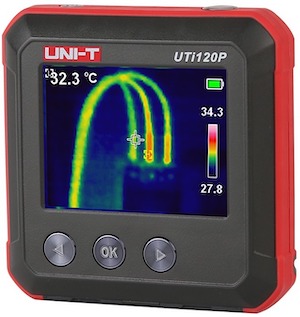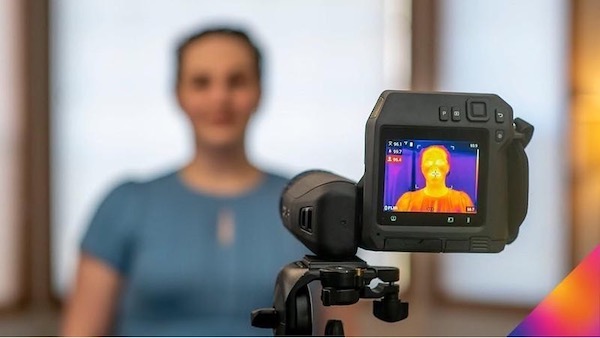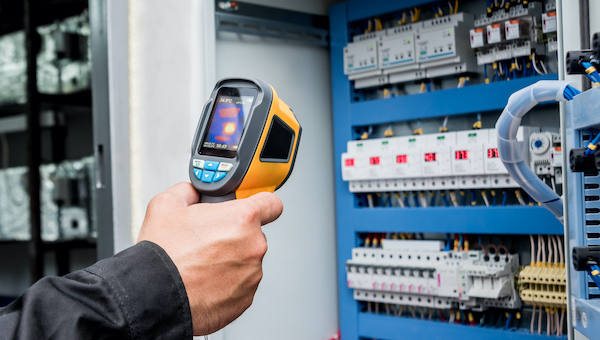Thermal Imaging Cameras

Figure 1: Thermal imaging camera
Thermal imaging cameras can detect and measure infrared radiation. Infrared radiation is a type of energy emitted by objects, and thermal imaging cameras use this to create images that show the temperature of those objects. The thermal camera technology was initially developed for the military and later adopted into various industrial sectors. Industrial applications include detecting the oxidation of high voltage switches, checking for insular defects, detecting overheated connections, scanning for gas or any other leaks in industries, etc.
Table of contents
- What is a thermal imaging camera?
- Thermal camera history
- How do thermal cameras work?
- Selection criteria
- Application examples
- FAQs
View our online selection of thermal imaging cameras!
What is a thermal imaging camera?
A thermal imaging camera is an optical instrument used to detect and display objects based on their temperature. The infrared radiation they emit can be detected by a thermal imaging camera, which transfers that information into an image that the camera operator can view, depending on the camera's resolution capabilities.
Thermal imaging cameras were typically used for military surveillance to detect heat from enemies in total darkness. However, they were later adopted in various industrial applications. For instance, thermal imaging cameras are used in electrical industries to detect incorrectly secured connections. They're also used for seeing through smoke and other particles that would otherwise block a person's vision.
A thermal imaging camera (TIC) detects the heat signature of an object and displays it on a monitor or on an output device such as a printout, graph, etc.
Thermal camera history
The word 'thermal' comes from the Greek word therma, meaning heat. Thermal imaging cameras have been around for more than a century. The principle of thermal imaging cameras is based on the concept that every object emits heat at specific rates. In other words, different things will emit different amounts of heat when heated to a particular temperature. Same temperature objects with different compositions and structures emit different thermal radiation, allowing for a specific fingerprint for identification purposes. The thermal emission spectrum depends on radiation and not composition. It is part of the light spectrum, broken down by wavelengths. Visible light is what we see with our eyes, and infrared is for thermal imaging. So, thermal cameras expand what we can see.
How do thermal cameras work?
Thermal imaging cameras work by using two sensors: the thermal infrared radiation sensor (which detects thermal radiation at wavelengths greater than 2500nm). They work similarly to an image sensor (used in traditional digital cameras to capture visible light images), but this is substituted with a thermal sensor to detect thermal radiation at longer wavelengths.
Thermal cameras detect infrared radiation using an array of sensors usually referred to as a focal plane array. The heat from a person, place, or thing is absorbed by infrared radiation then detected by the camera sensor. By detecting infrared thermal emissions from an object's surface, they are rendered on a monitor or output device such as a printout graph, etc., enabling straightforward interpretation of the thermal image data.
A thermal camera produces a high-definition image of all the items based on their temperatures. The hotter an object becomes, the brighter it seems in the thermal image, but the cooler an entity becomes, the darker it appears, with red being hot, blue being cold, and everything else in between showing up as oranges, yellows, and greens as seen in Figure 2.

Figure 2: Thermal imaging camera screen
Thermal camera usage during the day vs night
Thermal imaging cameras produce thermal images in complete darkness by recording the thermal radiation emitted by objects. Thermal imaging detects heat emitted from any object it observes. It is also called infrared thermography. Any object with a temperature emits heat, invisible to the naked eye. This thermal energy can be seen through a thermal camera that detects and displays it in various colors, previously black and white. Because of this technology, thermal cameras can be used in various ways, including seeing at night. Thermal imaging cameras are used in day and night applications depending on the thermal image settings.
Through walls, glass, underwater, or any object?
First things first, a thermal image shows temperature differences rather than temperature. For example, if the inside walls of your house were hot (say 50 degrees Celsius) and the outside walls were cold (at about -10 degrees Celsius), the thermal image would show what looks like one thick line (as the wall), indicating that there is a lot of heat pushing through the walls. A thermal camera cannot see through glass or water because these materials block infrared radiation.
Selection criteria
- Resolution: The quality of the image produced by the thermal imaging sensor depends on its detector sensor resolution. High sensor resolution allows a single point on an image to be sharper and more precise, allowing an operator to take more precise measurements and make better decisions. Sensor resolution is not the same as screen resolution. Detector resolution determines the quality of high-resolution displays.
- Temperature range:There will not always be a need to measure very high heat levels in all applications. In order to offer a wider temperature range, imaging devices will use more expensive sensors, and this will reflect in the instrument's price. Thermal imagining cameras are available for temperatures from as low as -20°C (-4°F) up to 1,700°C (3,100°F), depending on the camera specification and settings.
- Sensitivity: The sensitivity of an infrared sensor describes the smallest temperature difference it can detect. A device with a high thermal sensitivity can detect smaller temperature differences and therefore provide a more accurate image. The lower the milliKelvin (mK) number of a camera, the more sensitive it will be. As a result of the lower mK number, the camera will display more colors on its screen and detect a wider range of temperature differences.
- Optical magnification: x1 or x5. So, for every one millimeter of object height on the object being imaged, it will be 5 millimeters tall in thermal image data generated by a thermal camera.
- Accuracy: thermal imaging cameras provide thermal radiometric accuracy of ±2°C (3.6°F) or better.
- Emissivity: Emissivity of a material is the effectiveness of emitting energy as thermal radiation. Thermal imaging cameras allow users to select different emissivity values. Mainly depending on the object type and desired thermal data needed for thermal analysis. Most thermal cameras set the default emissivity value to 0.95, which can be adjusted from 0.10–1.00 for different applications.
- Focus modes: Thermal imaging cameras have an adjustable focus which allows closer viewing of the thermal emission source being imaged at various distances.
- Video output: thermal imaging cameras can produce live images in real-time. Thermal imaging technology detects thermal energy rather than visible light, which is the basis of traditional cameras.
Application examples
Thermal imaging cameras are used in various applications, including firefighting, rescue operations, night vision, surveillance, etc.
- Rescue operations: They are also an effective tool in the science and engineering fields for thermal analysis of objects under inspection. Firefighting thermal imaging cameras can be used to locate people trapped within a burning building without getting too close, minimizing the chances of firefighter injuries and fatalities during rescue operations.
- Firefighting:Thermal data from thermal cameras can be used to detect hotspots on roofs or other high-risk areas before they become significant fires, saving both time/money and infrastructure loss.
- Industrial applications: Many thermal imaging systems are general-purpose equipment and are well suited for industrial settings. They are built to last and are very resistant to industrial high-impact situations.
- Piping: With the help of a thermal camera, one can capture an image and study how heat is distributed within a piping system to detect irregular heat patterns likely to cause future breakdowns.
- Medicine: Thermal cameras are also used in medicine to help diagnose and treat medical conditions such as breast cancer, skin conditions, and infertility. They are also found in commercial spaces like warehouses to detect overheated machinery or insulation leaks.
- Military and civilian flight applications: One of the more interesting thermal imaging systems is the FLIR or Forward-Looking Infrared system. FLIR uses infrared cameras attached to an airplane, helicopter, or boat to detect where animals might be hiding under vegetation or whether a person is in the woods at night based on how much heat they give off.

Figure 3: Thermal imaging camera applications
FAQs
How do thermal imaging cameras compare to the naked eye?
Humans only detect visible light with their eyes and can't see thermal radiation. When an object is heated, it releases infrared radiation, which thermal imaging cameras detect.
How do thermal imaging cameras compare to other imaging technologies?
Thermal imaging cameras use a technology that detects infrared energy radiation while visual imagery detects visible light.




